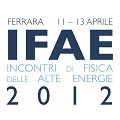Speaker
Description
Inserire un breve CV (solo per dottorandi che richiedono un contributo spese)
SARRA IVANO
Address: Via Pietrabbondante n.11 00132, Roma
Phone number.: 06/94038204 (cell.: 328/3584459)
Email: ivano.sarra@lnf.infn.it
Personal information
• Date and place of birth: February 12, 1982 - Rome
• Marital status: single
• Citizenzship: Italian
Education
• PhD student from November 2009 at “Tor Vergata” Rome University.
• “Tor Vergata” Rome University, Laurea in Physics. Final mark: 110/110 with distinction.
The argument of the thesis is: “Characterization of silicon photomultipliers connected to optical fibers and scintillators for electromagnetic calorimetry” - May 2009.
• Rome University “Tor Vergata”, Bachelor in Physics. The thesis argument is: “Development
and programming of a VME programmable logic interface (FPGA)” - 2005.
• Liceo Edoardo Amaldi, Rome, Diploma di Maturita’ scientifica – 2001.
Professional Experience
• FNAL (Fermi National Accelerator Laboratory of Chicago, USA): collaboration at the research program of the Dott. Robert Bernestein for Mu2e experiment. 15 of June – 10 of September 2011.
• FNAL (Fermi National Accelerator Laboratory of Chicago, USA): collaboration at the research program of the Dott. Robert Bernestein for Mu2e experiment. 8 of July – 11 of September 2010.
• FNAL (Fermi National Accelerator Laboratory of Chicago, USA): collaboration at the research program of the Dott. Robert Bernestein for Mu2e experiment. 16 of June – 10 of September 2009.
• Rome University “Tor Vergata” – INFN, Fellowship for young scientists; development and testing of electronics for nuclear physics. March 2006 – March 2008.
• Rome University “Tor Vergata”, Teaching assistant at the electronic degree course of Physics. 2005 – 2007.
Research Activity
Since 2008:
Participation to the R&D program for the electromagnetic calorimeter at low angle for the KLOE-2 experiment as starting job for his laurea thesis. In particular, he designs and develops new preamplifiers for the readout of Hamamatsu Silicon Photomultiplier (SIPM) and realizes a test-setup for the measurement of the SIPM characteristics (Gain, Dark Noise, dependences on Vbias, Temperature and so on.). Moreover, he participated to two different test beams:
1) In may 2008 and feb 2009 at the Beam test facility of LNF, where a beam of single electron of energies ranging from 100 to 500 MeV was used to characterize different prototypes of crystal calorimeters (PBWO+SIPM, LSO+APD).
2) In October 2008, at the blue hall neutron beam of the TSL laboratory of Uppsala, Sweden, where a prototype of the KLOE calorimeter has been exposed to neutron beams of 174 MeV energy.
Completed the design and the realization of a new amplification board for the readout of APD on crystal calorimeters.
From 16 of June to 10 of September 2009:
Participation at the research program for the Mu2e experiment @ FNAL. Simulation, in GEANT4, of the background brought from the radiative absorption of the negative pions for the violation of the lepton number with conversion on Al nucleus mu+N->e+N.
Simulation of the Radiative Pi Capture, internal note Mu2e-doc-665-v2.
From 8 of July to 11 of September 2010:
Participation at the research program for the Mu2e experiment @ FNAL.
Simulation in GEANT4:
Multiple Coulomb Scattering of a 105 MeV electron on Kapton, internal note Mu2e-doc-1080.
LSO crystal e.m. calorimeter response to a 105 MeV/c electron, internal note Mu2e-doc-1025.
2010-2011:
Completed the design and the realization of a new HV board for the APD.
Completed Proto LYSO Crystal Calorimeter for Mu2e experiment. The calorimeter is tested at the MAMI beam facility, Mainz-Germany, with a photons’ beam with energy between 30 and 300 MeV, March 2011.
From 15 of June to 10 of September 2011:
Participation at the research program for the mu2e experiment @ FNAL.
Simulation in GEANT4:
Clustering algorithms for the Mu2e calorimeter, internal note Mu2e-doc-1741;
Position reconstruction algorithm for Mu2e calorimeter, internal note Mu2e-doc-1807;
Calorimeter Trigger Study, internal note Mu2e-doc-1974.
| Si richiede un contributo spese? (solo per dottorandi) | si |
|---|

